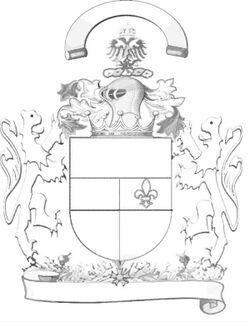Side (heraldry)
The side, or flank (Fr. flanc), is a heraldic ordinary resembling a pale that has been displaced (glissé) to either the dexter or sinister edge of the field. Pierre-Barthélemy Gheusi, following M. Aug. Tailhades, groups the sides (flanc dextre and flanc sénestre) with the chief and base (and bordure) as ordinaries (pièces honorables) that are affixed to an edge of the field by their longest side.[1]
The use of the term is not to be confused with the regions or edges of the field or points of an escutcheon—the dexter and sinister sides or points flanc dextre and flanc sénestre.[2] In English, sides as charges are typically referred to as ‘sides sinister’ or ‘sides dexter’, in contradistinction to the ‘sinister side’ and ‘dexter side’ as edges or portions of the field.
In some heraldic traditions, such as the English, it is specified that the side extend not more than one-sixth of the width of the field;[3] in others, such as the French, it may extend to up to one-third the width of the field.
Like other heraldic ordinaries—such as the pale, fess, chief, bend, base, or pile—the side is possessed of a fundamental ambiguity: it can be conceived as alternately a charge or as a division of the field. As with any principal charge, the side can bear another charge or a group of charges. Its edge can also be modified by variations of line. It can be modified by variations of the field as well.
Gallery
Coats of arms
Side
Březová-Oleško, Czech Republic
Pusula, Finland
Longkamp, Germany
Werra-Meißner-Kreis, Germany
Side sinister
On flags
Side on flags
Side sinister on flags
References
- ↑ Gheusi, Pierre-Barthélemy (1892). Le blason héraldique: Manuel nouveau de l'art héraldique de la science du blason et de la polychromie féodale d'après les règles du moyen age avec 1300 gravures et un armorial. Paris: Librairie de Firmin Didot et c.. p. 40. https://www.google.com/books/edition/Le_blason_h%C3%A9raldique/fApBAQAAMAAJ?hl=en&gbpv=1&bsq=flanc%20dextre.
- ↑ Gheusi, Pierre-Barthélemy (1892). Le blason héraldique: Manuel nouveau de l'art héraldique de la science du blason et de la polychromie féodale d'après les règles du moyen age avec 1300 gravures et un armorial. Paris: Librairie de Firmin Didot et c.. p. 22. https://www.google.com/books/edition/Le_blason_h%C3%A9raldique/fApBAQAAMAAJ?hl=en&gbpv=1&bsq=flanc%20dextre.
- ↑ Gough, Henry; Parker, James (1894). A Glossary of Terms Used in Heraldry (New ed.). Oxford and London: J. Parker and Co.. p. 541. https://books.google.com/books?id=luMMAAAAYAAJ&q=side#v=onepage&q&f=false.
 |




























